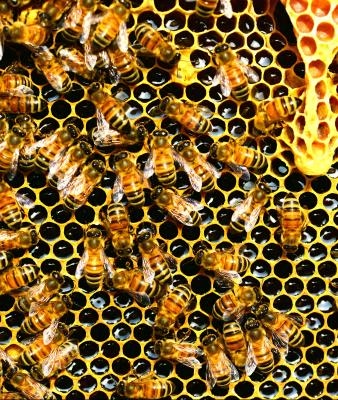Sweet honey is made from nectar collected by bees. Its origins are said to date back to 1600 BC. Ancient Egyptians even considered it a highly valued food. Honey is primarily composed of sugar. What are its benefits? If you want to preserve honey for a long time without spoiling, what are the recommended methods for storing it?
Now, we finally get to the most important bee product from the beehive for beekeepers and bees: honey. We will examine the following topics: nectar plants, honey production, honey composition, and different types of honey.
A Brief History of Honey from the Beginning
Without bees, there would be no honey. In fact, honey exists solely because of bees.
Primitive humans in the Paleolithic Age were stealing honey from bees (using methods similar to those of bears)—ancient cave paintings confirm this. Documents dating back to 1600 BC indicate that humans fed honey to children and used it to treat illnesses. Did you know that the ancient Egyptians not only buried their treasures in their tombs, but also buried honey with them?
Beekeeping technology didn’t truly develop until the ancient Egyptian era. Later, with the arrival of sugarcane in Europe, honey lost its prestigious status. The Continental Blockade during Napoleon’s reign led to a surge in the use of beet sugar. After that, honey became increasingly rare on the table.
I’d like to briefly discuss the differences between honey, sucrose, and beet sugar.
Differences Between Honey, Sucrose, and Beet Sugar
Sucrose and beet sugar are both disaccharides, which cannot be directly absorbed by the human body. Honey, on the other hand, is composed of fructose, glucose, vitamins, minerals, trace elements, and various enzymes. Sucrose is a dead food and a carrier for microorganisms. In contrast, honey is a living food; it doesn’t carry microorganisms and even has antibacterial properties.
Where does honey come from?
Let’s start from the beginning. Soil, plants, and bees, along with sunlight and water, form a natural mini-factory.
Plants capture sunlight’s energy through the chlorophyll in their chloroplasts. This process is called photosynthesis. Through their roots, plants absorb minerals, nitrogen, and water from the soil, using their stems as a transport channel for these nutrients.
To sustain plant life, they possess a vital organ: flowers. Flowers do their best to attract bees. To thank the bees for visiting them, they secrete nectar that flows to the base of the calyx, where the bees can gravitate.
How do bees make honey?
A worker bee discovers a beautiful, blooming flower.
The worker bee lands on the flower and uses its mid-tongue to scoop up the nectar (which at this point contains approximately 50-80% water). When the nectar sac is full, the worker bee flies back to the hive.
During flight, the nectar in the sac evaporates by 50% of its water content. The concentrated nectar is mixed with fluid secreted by glands in the head. It then travels back and forth between the pharynx and the honey sac, where it is combined with various enzymes to form honey.
When a worker bee returns to the hive, it uses muscle contractions to release the honey into the cells. It then flies out again to collect honey until the entire cell (comb) is filled. When the honey’s moisture level drops sufficiently (between 15 and 20%), the worker bee seals it with a thin layer of beeswax.
Miellat
We’ve already tasted honey, so let’s talk about miellat, or miel des forêts. Honeydew honey is unique in that it isn’t made from nectar. Aphids or scale insects use their mouthparts to pierce the outer tissue of plants to extract the sweet juices. Aphids often gorge themselves on the sweet juices, consuming amounts equal to their own body weight.
When an aphid overfeeds and is unable to digest it, it contracts its intestinal muscles, expelling the sweet juice (which has undergone some transformation within the aphid’s body) into a large droplet of liquid known as “nectar.”
This droplet eventually drips (sometimes aided by the aphid’s legs) onto leaves or needles of trees such as fir, oak, maple, pine, or spruce. Worker bees then collect the thousands of drops of nectar dispersed by the aphids to make nectar honey.
While bees can use nectar honey as food, it’s not recommended for them to store for the winter, as it could cause diarrhea.
These are the main nectar-producing plants.
Honey Composition
18% Water | 78% Sugars (Glucose, Fructose, and 1-2% Sucrose)
Minerals | Trace Elements | Vitamins B1, B2, B3 | Various Digestive Enzymes
Benefits of Honey
Energy Supplement | Vitality Enhancement | Nourishing | Antibacterial | Calcium Supplement
Each type of honey has unique properties depending on its source.
Honey Packaging
Before introducing the different honey packaging options, let’s discuss a French beekeeper who claims to have invented tube-packaged honey. While an interesting idea, it’s not entirely innovative. In fact, Mr. John F. Hawkins of Chester County, Pennsylvania, was already selling tubes of honey around the 1950s.
Honey packaging has evolved significantly since the early 20th century: crystallized honey was initially presented as a large block. This was then cut into blocks using steel wire, depending on the customer’s needs, and then wrapped in baking paper.
Today, honey packaging has evolved in response to environmental concerns. When you buy honey at the market, you’ll find packaging in glass jars, plastic jars, and paraffin-treated cardboard boxes. Essentially, it needs a sealable lid, some with attractive embossing for added appeal. A variety of packaging materials can be found at specialized beekeeping stores.
How to store honey?
I wonder if you’re like me: when I hold a jar of honey in my hands, I can’t resist opening it and trying it. Oh, and I almost forgot to mention: don’t store honey in high temperatures, as it may ferment.
If you want to store honey long-term, keep it at room temperature, around 14°C. If you prefer liquid honey, you can melt it in a water bath, but be careful not to boil the water. (The standard is that the water should not feel hot when you test it with your finger.)


Leave a Reply